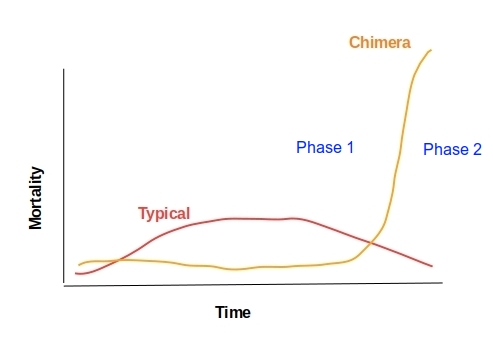Chimeric virus - "Combining two pathogenic viruses increases the lethality of the new virus".
This chart shows diseases according to their mortality (deadliness) and mobility (contagiousness). This is a classic X * Y = K graph depicting an environmental constraint. High mortality reduces mobility and vice versa.
If you're a bioweapon designer, though, your goal is that empty upper right quadrant, i.e. maximum mortality AND mobility. How can you reach that goal?
From an algebraic view, assume X * Y = K where K = 100:
OR
Assume a typical virus at 10 * 10 = 100
Now assume we can design the behavior by separating it into two phases:
AND
So we're still within the original constraint (100) but increased mortality from 10 to 25 and mobility from 10 to 25. In other words, traditional virologists are now dealing with something TOTALLY outside of their models.
Let's look at one ramification of the new model.

To maximize mobility, the weapon should minimize mortality at first. It will look deceptively innocuous for most of its life. But mortality will rise drastically at the end. The average virologist could be baffled by its behavior because it violates a well-known model Right now, the Wu Flu's rate is reported as 3%, 15% or 55% mortality rate, depending on when its measured and who is measuring it.
A natural virus does TWO things poorly ALL the time, mobility and mortality.
This virus does ONE thing well for MOST of the time... mobility.
And then it switches and does a DIFFERENT thing well... mortality.
If this is a chimeric virus, I'd expect the final rate to be closer to 55% than 3%.

Comments